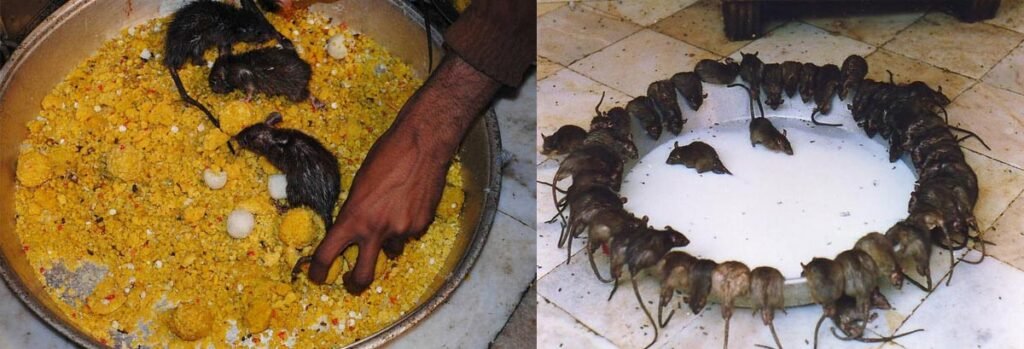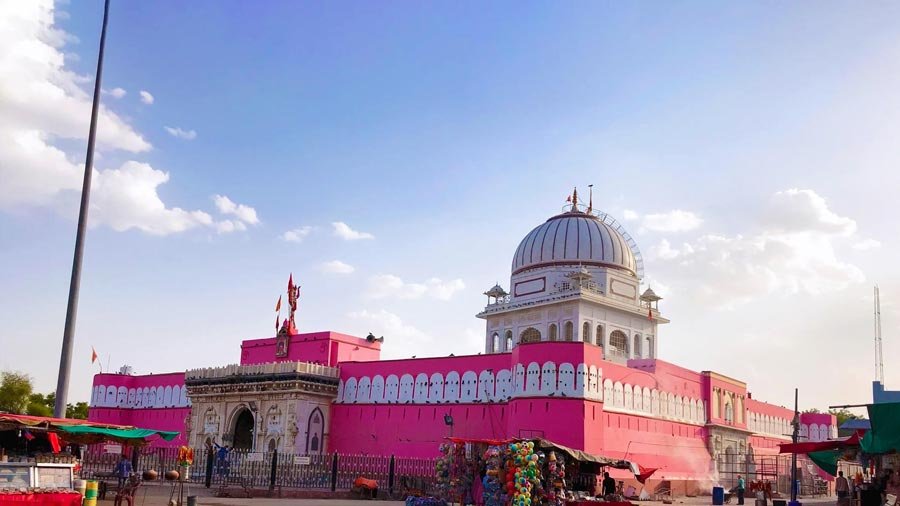The Karni Mata Temple located in Deshnoke, Rajasthan, is an astonishing site that is home to over 25,000 holy rats. This unique temple is dedicated to the Goddess Karni Mata, an incarnation of Durga, and contains throngs of black rats that are revered by devotees as sacred.

For adventure seekers, spiritual souls, and cultural enthusiasts visiting Rajasthan, a trip to the remarkable Karni Mata Temple offers an opportunity to experience a one-of-a-kind sacred site that is renowned for its abundant rat population.
The Goddess Karni Mata and the Temple’s Origins
The Karni Mata Temple is dedicated to Karni Mata, a highly venerated sage and incarnation of Goddess Durga. Born in the 14th century into the Charan caste, Karni Mata was revered for her healing powers, mystical abilities, and military strategic skills. She played a key role in many regional historic battles.

Today, local legends and folklore recount tales of Karni Mata’s miracles. The most famous story describes how Karni Mata negotiated with Yama, the god of death, to revive her drowned stepson, Laxman. Yama conceded, allowing Laxman’s soul to reincarnate as a rat. This origin story lies behind the temple rats’ elevated status.
The original Karni Mata temple was constructed in the 15th century. In the early 1900s, the current larger temple was commissioned by Maharaja Ganga Singh of Bikaner. He modelled it on the stunning white marble Taj Mahal. The temple boasts beautiful carvings, columns, and silver ornamented doors.
25,000 Sacred Rats Revered as Family
While many visit the temple to pay respects to Karni Mata, most are drawn by the mystique of its famous resident population of rats. These thousands of black and brown rats and the rarer white rats are treated as sacred, protected, and worshipped here.

The majority are the common Indian field rat, but visitors can spot larger rat species too. According to legend, these rats are Karni Mata’s descendants, specifically her sons and clansmen reincarnated after death. Hence the rats are affectionately called ‘kabbas’ – sons of Karni Mata.
Devout pilgrims visiting offer the rats prasad, sweets and food intended as offerings. Harming or disturbing the rats is forbidden and considered offensive. Some who accidentally injure a rat compensate by replacing it with a solid gold or silver rat statue.
Spotting an elusive white rat among the masses is an exceptionally fortunate omen. Albino white rats are rare, making up only 1 in every 10,000 rats here. They hold special significance, representing the abode of departed souls.
Engaging in Temple Activities
The Karni Mata Temple buzzes with energy day and night as devotees and tourists join in rituals and explore the premises. Visiting early morning is ideal for avoiding crowds that swell in the afternoons. Be prepared to remove footwear at the entrance and navigate the interior barefoot alongside the masses of rat residents.
Devotees who wish to show dedication and respect can bring offerings to dedicate at the shrines. Simple sweets, nuts, and grains satisfy the rats while pleasing temple priests. Visitors can also partake by sampling the karah prasad, a holy sweet paste offered at temples.
Join in the aarti rituals taking place at scheduled prayer times. Marvel at the enthralled dancing, chanting, and music in the inner sanctums as priests light candles and incense, waving them in worshipful patterns and clanging cymbals rhythmically. These rituals immerse you in the sights, sounds, and smells of age-old Indian worship customs.
Explore the intricate silver doors, detailed marble lattice panels, carved pillars, and vivid painting work throughout the temple. Notice the shrines and statues honouring Karni Mata, her sisters, and other important religious figures from the region’s history and mythology.
Admiring the Intricate Architecture
The Karni Mata Temple wows visitors with its fine marble carvings and silver embellishments from the first glimpse. Walking through the towering silver-plated gates into the main courtyard, you are surrounded by finely etched marble lattice screens, chhatris (domed pavilions), and painted murals depicting mythological scenes.

The main shrine lies straight ahead, with the idols of Karni Mata and her sisters cast in pure gold and clad in decadent attire, jewellery and flowers. To the right is the shrine to Karni Mata’s stepson Laxman, whose drowning and reincarnation legend is naturally tied to the resident rats.
While the original 15th-century temple was relatively modest, the early 1900s renovations commissioned by Maharaja Ganga Singh expanded it greatly. His vision was to model it after the famed Taj Mahal. The temple now spans two interconnected building complexes, featuring elaborate pillars, arches, and extensive marblework.
Understanding the Cultural Significance
In the local Bikaner region, Karni Mata is revered as an incarnation of Durga, the powerful protective mother goddess. She is intrinsically tied to the desert area’s history and folklore through her early 14th-century life as a mystic matriarch who demonstrated compassion and performed miracles.
Karni Mata’s close association with rats likely stems from her early life in the Charan caste, who worshipped rats as vehicle mounts for the rat-riding war god Karni Kumar. Rats also held cultural symbolism for attributes like adaptability and survival.
Today at the temple, the unanimity between devotees and rats reveals a unique acceptance of wildlife within sacred spaces. The coexistence reflects a facet of Hindu dharma where divinity permeates both humans and animals. Understanding these contextual nuances brings deeper appreciation.
Practicing Mindful and Ethical Tourism
When visiting the Karni Mata Temple, respect the dress code requiring modest clothing that covers shoulders and legs. Avoid littering and clean up any trash around your area. Be cognizant of crowding or inconveniencing devotees. Consider making a small donation to support the temple’s upkeep and staff.

While the temple rats are cared for, kindly avoid touching or feeding them. Be mindful of their well-being and give them adequate space when taking photos. Ensure children do not disturb or chase them. As a tourist, aim for ethical practices that minimize your footprint.
Accessing the Temple
The temple is located around 30 km from Bikaner and can be reached by bus, auto-rickshaw, or taxi. The nearest rail station is Deshnoke Station, just 1 km away. From here, you can easily walk or take an auto-rickshaw for ₹10-20.
Buses run regularly between Bikaner and Deshnoke, dropping you right at the main bus stand. The temple is a short walkable distance or 5-10 minute rickshaw ride (₹20-50) from here. Most of the route is wheelchair and stroller accessible, though some parts may present challenges.
A Surreal and Spiritual Experience
My visit to the Karni Mata Temple was tinged with excitement, nervousness, and inquisitiveness. I was unsure how I would react to the sheer masses of unrestrained rats occupying every corner and surface. However, observing them up close moving about freely according to their instincts within the pristine marble temple was a unique experience. A few daringly crawled up my legs which initially shocked me before melting into amusement.
Seeing the devotees unflinchingly offering sweets to eagerly awaiting rats, the sincere reverence of the kabbas as extended family, and hearing tales of Karni Mata’s miracles painted a larger cultural and spiritual context. This allowed me to set aside preconceived notions and appreciate the temple for its cultural immersion.
While teeming with rodents, the temple astounds visitors with its graceful beauty, vibrant energy, and faith-filled aura. For the open-minded tourist, a visit promises beautiful architecture, intriguing legends, and invaluable cultural learning. As an unforgettable site where the secular and sacred converge, the Karni Mata Temple should top your Rajasthan itinerary.
The Karni Mata Temple offers a fascinating look at local culture, religion, spirituality, mythology, architecture, and wildlife found nowhere else on the planet. While its rat residents may seem bizarre at first glance, learning the legends behind them allows one to appreciate them in the proper cultural context. Respectful visitors are sure to find a trip to this incredible temple enlightening, entertaining, and memorable for a lifetime. Don’t miss out on the magic and mystery of Rajasthan’s legendary Karni Mata Temple.
Read more from the website:
